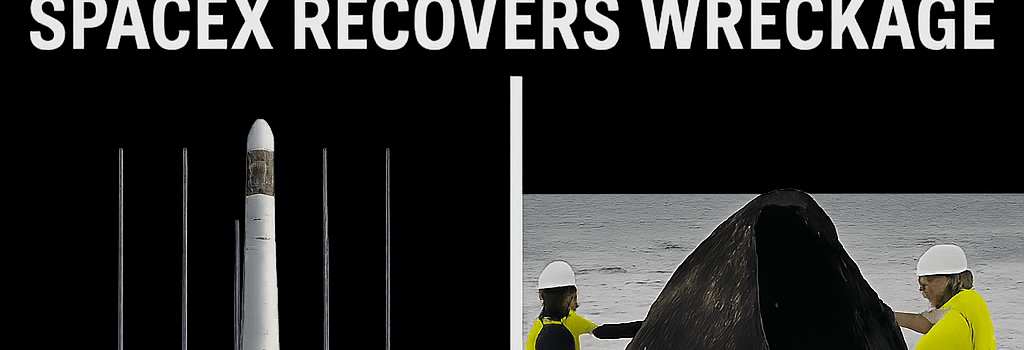Rocket Report: Future at Wallops; SpaceX Recovers Wreckage

Welcome to Edition 8.04 of the Rocket Report. This week we dig into the Pentagon’s Golden Dome missile‐defense shield, SpaceX’s ocean salvage operation, environmental rule rollbacks, startup SPAC deals, NASA science missions, private Chinese launch progress, maritime logistics for new medium‐lift rockets, SLS upper-stage alternatives, and more.
1. Golden Dome’s Space-Based Interceptor Challenge
The Pentagon’s Golden Dome architecture seeks to layer terrestrial sensors, space-based satellites, and in-orbit interceptors to protect the homeland. Gen. Michael Guetlein recently told Ars Technica that while command-and-control nodes can be fielded rapidly via software‐defined radios and crosslinked data buses, the real hurdle lies in deploying thousands of space-based interceptors.
Technical Specifications Under Review
- Interceptor mass: ~500 kg fully fueled
- Propulsion: bipropellant thrusters (hydrazine / MON-25) for station-keeping, solid rocket motor for boost‐phase intercept
- Delta-V budget: >2 km/s for in-orbit repositioning
- Sensor suite: multi-band infrared seeker, photonic Angular Rate Sensors, and LIDAR
“We’ve proven the physics in ground tests, but scaling into the thousands means new manufacturing lines, raw-material sourcing, and automation to drop per-unit costs by an order of magnitude,” Guetlein said.
2. Northrop Grumman’s Ground Tests for In-Space Kinetic Kill Vehicles
Northrop Grumman has been quietly conducting full-scale ground tests of interceptor mock-ups under its Golden Dome proposal. CEO Kathy Warden noted that company engineers are validating structural loads, thermal shielding, and closed-loop guidance algorithms on high-g sled tracks.
Expert Opinion
Dr. Elena Martínez, former director of DARPA’s Responsive Space Office, commented: “Northrop’s use of additive manufacturing for titanium-aluminide frames could shave 30% off mass and accelerate prototyping timelines. But integration of seekers into a hardened bus remains unproven.”
3. Regulatory Shift: Trump Administration to Expedite Launch Licensing
A ProPublica leak reveals a draft executive order directing the Department of Transportation to “eliminate or expedite” environmental impact statements for commercial launches. It would also convert the FAA’s Office of Commercial Space Transportation head into a political appointee. This change aligns with SpaceX’s long-running tussle over NEPA reviews for Starship launches.
4. SPAC Ambitions: iRocket’s Public Listing Gamble
Innovative Rocket Technologies Inc. (iRocket) is merging with a Wilbur Ross-backed SPAC at a $400 million valuation. Yet last filings show the SPAC holds just $1.6 million in trust, while iRocket has only raised mid‐single-digit millions in venture capital.
Market Context
- Competitors Rocket Lab and Firefly Aerospace have flown small orbital vehicles like Electron and Alpha.
- Stoke Space, Relativity, Orbex and others are vying for sub-500 kg payload markets with more mature test programs.
- iRocket’s Shockwave design aims for full reusability and 24-hour turnaround, but has no publicly demonstrated static‐fire to date.
5. NASA’s TRACERS Mission: Plasmas in the Polar Cusps
On July 23, SpaceX launched two TRACERS satellites aboard Falcon 9 from Vandenberg. Each 350 kg spacecraft carries a suite of plasma analyzers (Langmuir probes, Faraday cups, magnetometers) to map particle trajectories in Earth’s polar cusps. Secondary payloads include:
- Experimental laser communications terminal (100 Mbps link)
- Modular satellite bus demo built from standardized cubes
- Atmosphere-radiation coupling study tools
- 5G CubeSat by ESA
- Five Australian hyperspectral nano-sats
6. Space Pioneer’s Tianlong 3 Launch Pad Activation
Chinese private player Space Pioneer completed an acceptance test of its new Jiuquan launch pad for the nine-engine Tianlong 3 rocket. The vehicle uses a kerosene/LOX core stage with 9 methalox first-stage engines delivering 4 MN total thrust, targeting 14 tonne LEO capacity.
Previous Test Failure
In June 2024, a static-fire test resulted in an uncontrolled ascent due to a weak tail-structure design. Engineers have since retrofitted reinforced composite struts and optimized engine gimbal actuators.
7. Maritime Logistics: Rocket Lab’s Neutron and Wallops Dredging
Rocket Lab plans to launch its Neutron medium-lift rocket (beamed‐LOX upper stage, 80 tonne LEO capacity) from MARS on Wallops Island, VA. The island is accessible only at low tides through narrow channels, so the company requested temporary “kedging” permits for five initial shipments while awaiting an Army Corps dredging approval.
8. SLS Exploration Upper Stage Alternatives
Congress is considering directing NASA to evaluate alternatives to the Boeing‐built Exploration Upper Stage (EUS), whose development has ballooned to $2.8 billion. Options include a dual-engine Centaur V derivative, leveraging ULA’s Vulcan upper stage design with RL10C-2 engines (110 kN each) for reduced cost and risk.
9. SpaceX Recovers Super Heavy Booster Wreckage
For the second time, SpaceX salvaged the tail section of a Super Heavy booster from the Gulf of Mexico—likely Booster 13 from November’s Starship test. The recovered segment includes most of the 33 Raptor engines, offering engineers valuable data on structural deformation and saltwater corrosion after high-speed ocean impact.
“Salvage lets us non-destructively inspect fracture surfaces and evaluate nozzle erosion rates,” said a SpaceX propulsion engineer speaking anonymously. “This drives next-gen heat‐shield materials and landing leg damping designs.”
10. Supply Chain and Manufacturing Challenges
Across all sectors, from interceptors to reusable boosters, rapid scaling faces raw‐material constraints—titanium, carbon fiber, and specialized alloys. Industry experts point to blockchain-backed provenance tracking and additive manufacturing as keys to securing supply chains and slashing lead times from months to weeks.
11. Cost-Efficiency and Scalability of Space-Based Defenses
A recent RAND Corporation study estimates that deploying 5,000 space-based interceptors at $10 million per unit yields a total program cost exceeding $50 billion. Analysts argue for hybrid architectures combining high-altitude drones and directed-energy systems to reduce per-engagement expense.
12. Future Outlook: The Next Frontier
As commercial launch cadence accelerates—projected 1,200 orbital launches by 2030—the overlap of defense and civilian space traffic will demand robust space‐traffic management (STM) frameworks, automated conjunction assessment, and in-orbit servicing capabilities. The coming decade will test whether public-private partnerships can deliver resilient, scalable space architectures at sustainable costs.
Next Three Launches
- July 26: Vega C | CO3D & MicroCarb | French Guiana | 02:03 UTC
- July 26: Falcon 9 | Starlink 10-26 | Cape Canaveral | 08:34 UTC
- July 27: Falcon 9 | Starlink 17-2 | Vandenberg | 03:55 UTC
Stephen Clark, Space Reporter